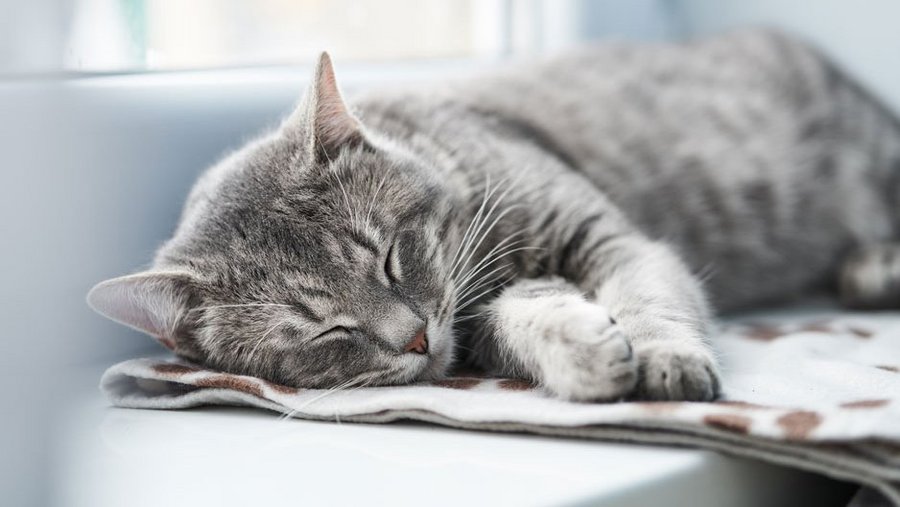You’ve probably noticed that your cat repeatedly assumes typical sleeping positions. Their posture patterns vary from lateral position to upright when snoozing with a laid down or held up head that reveals a lot about their state of mind. And what about all those funny pictures showing cats in all sorts of contortions? These say one thing above all: the cat has simply been overcome by sleep after playing and romping. Small cats can relax any time and anywhere. That’s because they have not yet had any bad experiences. This changes later on. Based on the typical sleeping postures, you can tell whether your cat is relaxed or somehow unhappy.
The classic: the curled cat
This is the most original of all sleeping positions. Here your cat lies on its side and pulls its head and legs together. Its tail is often wrapped around its body. The front and back legs touch each other or lie crossed. This is the posture that wild cats and their tame relatives have adopted for thousands of years. The cat makes itself small and thus offers little surface area for wind and weather to attack. But you needn’t worry about that. Your cat is not freezing; it is simply sleeping in one of its most natural sleeping positions.
Another typical sleeping position: half curled up
Here your cat also lies on its side. The front legs are slightly tucked in, and the tail and hind legs are stretched out. Sometimes the face is covered by a paw. The head is on the floor – a sign that your cat is actually sleeping. A cat in this position feels safe and is deeply relaxed. And it wants one thing above all: not to be disturbed.
Ready to escape: On all paws
This position is also part of your cat’s standard repertoire. It sits on all paws, the belly is laid down on it, and the head is raised. The front paws are either folded or retracted. In this position, the eyes are usually half open. Many cat owners consider this posture to be a particularly contented posture; however, the opposite is true. The raised head indicates: This cat is not really asleep – even if it keeps its eyes closed. It is dozing but ready to escape at any time. This posture is often also a sign that your cat is unhappy with something. If your cat turns away from you, it is definitely annoyed by something. If you notice that your feline friend takes this position particularly often, this can be an indication of pain. You should then pay attention to whether your cat eats normally and drinks and visits the litter box regularly.
Good compromise: The lateral chest position
A variation of upright resting is the semi-upright position. The cat’s abdomen is on its side, and its hind legs are extended. The chest and head are upright, and the paws are “interlocked”. In this position, your pet is much more relaxed than when lying upright. Your cat can recharge its batteries and relieve its lungs. Nevertheless, it still has full control.
Especially restful: side position
If your cat lies on its side with its head down and its legs loosely stretched out, it will have a particularly restful sleep. This position is especially comfortable for your cat. It feels safe and has no worries. At this moment, it is recharging its batteries and will be fit for the next undertakings after this deep relaxation.
Phew, that’s warm: lying down for a long time
You will often observe this position in summer: Your cat lies on its side and stretches out for a long time. In this way, it tries to soak up as much of the cool ground and radiate off as much heat as possible. If you see your feline friend lying like this, it’s time to unpack the self-cooling mat or open the door to a particularly cool room.
Deep relaxation: On its back
Few cats present themselves like this. For you, it’s a cause for joy because your cat feels completely at ease and trusts you completely. The fact that it shows her belly, its most vulnerable spot, tells you that it feels one completely safe with you. If your cat is awake, you can carefully try out whether it lets you cuddle it. But if it is asleep, you should not disturb it.
What type is your cat? A highly relaxed one? Or a more alert one? How often does your cat sleep and in what position? If it sleeps in the relaxed position quite often, you can be satisfied with yourself and the overall situation. It is also important how much your cat sleeps. It should be at least 13 hours; the average is 16 hours. If it does not find rest, you can improve the situation. Maybe it wants a raised sleeping place or needs a particularly undisturbed resting place. Your careful observation can even help you to detect diseases. It’s worth keeping an eye on your pet’s resting habits. Because as you can see: Your cat always speaks to you. Even in sleep.

